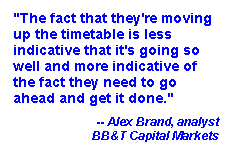|
New home effort by FedEx
|
 |
June 27, 2000: 12:10 p.m. ET
Company will speed up plans to reach homes with low-cost ground service
|
NEW YORK (CNNfn) - FedEx Corp. sped up its slowest offering Tuesday, announcing it will expand residential deliveries by its lower-cost ground delivery service faster than previously planned.
The company said it now plans to reach 80 percent of the nation's homes with its FedEx Ground service by fall of next year, and have complete national residential coverage by September 2002, more than a year earlier than originally planned.
The express delivery company's unit, formerly known as RPS, concentrated on business-to-business deliveries until last fall, when it started a pilot program to make the most time consuming and costly home deliveries. It is seen as the company's answer to competitor United Parcel Service's dominance in the sector, and the growing service improvements, such as electronic delivery verification and express carrier partnerships, recently introduced by the U.S. Postal Service.
 FedEx's core overnight or two-day delivery service is not cost competitive for many residential shipments. Surveys have shown that most consumers buying goods online use UPS for the delivery, with the Postal Service second; FedEx is a distant third with only about 10 percent of the market. FedEx's core overnight or two-day delivery service is not cost competitive for many residential shipments. Surveys have shown that most consumers buying goods online use UPS for the delivery, with the Postal Service second; FedEx is a distant third with only about 10 percent of the market.
FedEx, which is set to report earnings Wednesday morning, did not give any details of the costs of the expansion or the impact on future results. It said it was doing it due to strong response from its first three months of the new home delivery effort.
"Business-to-consumer shippers and their customers have responded enthusiastically to the innovative service options that FedEx Home Delivery brings to the residential market," said Daniel J. Sullivan, chief executive of the FedEx Ground unit.
An analyst said he believes the effort will hurt profitability in the coming two years, but that the company had no choice given the direction of the market.
"The fact that they're moving up the timetable is less indicative that it's going so well and more indicative of the fact they need to go ahead and get it done," said Alex Brand, analyst with BB&T Capital Markets. "I think it is something they have to do to compete effectively with UPS. Certainly it brings some uncertainty to the next year or two for them in terms of profit and their ability to execute those plans."
The residential delivery market is expected to boom in the next three years, driven almost completely by the growth of e-commerce purchase by consumers. A study last fall by Forrester Research projected that there were 2.98 million daily packages delivered to residences last year, with only about 600,000 of those from e-commerce. But it projects that that would grow to 6.5 million daily package deliveries by 2003, despite traditional catalog and other traditional shipments staying level during the period.
 FedEx is trying to differentiate itself from UPS and the post office by setting up a separate network of distribution centers and truck drivers to make the home deliveries in off-hours, such as evenings and weekends, when consumers are more likely to be found at home. It already had a separate delivery system for its express packages that generally moved by air and its lower cost ground delivery service. FedEx is trying to differentiate itself from UPS and the post office by setting up a separate network of distribution centers and truck drivers to make the home deliveries in off-hours, such as evenings and weekends, when consumers are more likely to be found at home. It already had a separate delivery system for its express packages that generally moved by air and its lower cost ground delivery service.
Analysts debate whether the separate delivery services are an advantage of disadvantage for FedEx's efforts in the lower-cost sector.
"I think FedEx over-engineers solutions in many cases," said Brand. "UPS doesn't see the need to have two separate systems and it seems to work pretty well."
But Doug Rockel, analyst with ING Barings, thinks FedEx's plans will help keep the costs of ground delivery service lower in the long run.
"If they had not done a separate network, it would have created problems for Federal," he said. "I know there are some added costs because of it, but I think there could be cost savings in the future."
Rockel agreed with Brand that the speed up of the residential offering could lower earnings over the next two years, but he is more optimistic that FedEx is doing it in response to strong market demand for the product.
FedEx said as part of the speed up of the expansion effort it plans to open 150 new distribution centers by next March, increasing the coverage to 70 percent of the nation's home. FedEx Ground now serves homes in 37 major metropolitan areas, which encompass about 50 percent of homes nationwide.
Plans to get to the 80 percent coverage level by September of 2001 and the complete coverage by September 2002 are still being devised. At the time the launch of the product was announced in March, FedEx expected to reach national coverage in 2003.
Analysts waiting for earnings impact of effort
Analysts surveyed by earnings tracker First Call forecast that FedEx will report earnings of 81 cents a share when it reports fiscal fourth-squarter results Wednesday, up from 73 cents a share a year ago. The company is seen earning $2.61 a share in fiscal year 2001, up from the forecast of $2.28 a share it expected to report for fiscal year 2000. Any earnings guidance presented Wednesday will have a lot of impact on the stock, predicts Ed Wolfe, analyst with Bear Stearns.
"If after the report on Wednesday investors believe that FedEx will be able to post double-digit (earnings per share) growth during the first half of the fiscal year 2001, we believe the stock should begin to act a bit better," said Wolfe. "If FedEx management guides the street downward, we believe the stock will be dead money for some time."
Shares of FedEx (FDX: Research, Estimates) gained 2-1/16, or 6 percent, to 36-1/8 in trading Tuesday. 
|
|
|
|
|
|
FedEx
|
Note: Pages will open in a new browser window
External sites are not endorsed by CNNmoney
|
|
|
|
 |

|

